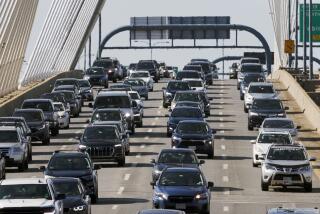The Cutting Edge: COMPUTING / TECHNOLOGY / INNOVATION : McLaren Hopes the Race Goes to Swiftest Data Crunchers : Automotive: The team’s Formula One cars send a river of information back to the pits for crew to analyze.
- Share via
For anyone familiar with the intensely competitive world of Formula One auto racing, it would hardly be a surprise to learn that the Marlboro McLaren Mercedes MP4/10 is chock full of fancy technology. Formula One has long been a test bed for everything from engines to aerodynamics, with innovations honed on the racetrack later finding their way into the family sedan.
But when it comes to the elaborate data-gathering, wireless communications and networked computer systems that support the McLaren team, well, you probably won’t have that in your garage any time soon. When the McLaren cars race, they turn into veritable rivers of information, with data collected and analyzed instantly via something known as the Advanced Telemetry Linked Acquisition System, or ATLAS.
While all the leading Formula One teams make heavy use of technology, McLaren carries its number crunching to an extreme. It hasn’t helped the team too much this year: After eight races, it’s languishing in fifth place, having weathered a damaging series of driver changes.
But, as the car evolves over the season aided by data feeds from each race, the team might make a comeback. “McLaren isn’t as good as the hottest teams on the track,” says Barry Winfield, technical director of Car and Driver magazine. “But these things go in cycles. Whoever makes the best use of the latest technology has an edge.” The ATLAS system begins with sensors--150 of them--that measure every aspect of the car’s performance, from fuel consumption, speed and engine “revs” to oil and water temperature. An antenna zaps the information back to a network of six high-powered Sun workstations and one portable workstation in the pit garage.
At the garage sits Dieter Gundel, head of systems engineering for McLaren. Gundel and five other engineers determine how much of the torrent of bytes needs to be relayed, via a wireless Ethernet connection, to an engineer at the pit “wall”--who is in constant communications with the drivers--and his four portable Sun workstations.
The sensors can send back 10 megabytes of information per car, per lap: For a typical 80-lap race, the total is almost one gigabyte. But only a small portion of that is useful for tactical decisions during the race: The rest is stored for later analysis.
“During the race, we’ve been concentrating on engine parameters,” as the most crucial data needing instant analysis, says Gundel. Among the complications this year were tighter safety measures (though these have become something of an annual ritual)--which reduced engine size to three liters from 3.5 liters--and the fact that Marlboro McLaren ended their relationship with Peugeot and signed on Mercedes as the engine maker. After seven races, the new engine is still being broken in.
ATLAS uses a series of pre-programmed software modules to assess data and do performance comparisons. This year, ATLAS has helped with the performance of the semi-automatic gearbox. Adjusting the timing by a few milliseconds--possible because of the sensors’ high sampling rate--made a big improvement in the smoothness of gear shifts, according to Gundel.
After each race, a mountain of performance data is fed back to McLaren’s facility in Surrey. There, the design process is speeded by CAD software and “concurrent engineering”--which allows instantaneous information sharing among designers.
Even with all this technology, though, Gundel readily concedes that “the driver is the best sensor.” True remote control of car function remains illegal in Formula One racing--and the thrill, after all, lies not in the cars or their computers, but in people pushing them to the limit.






